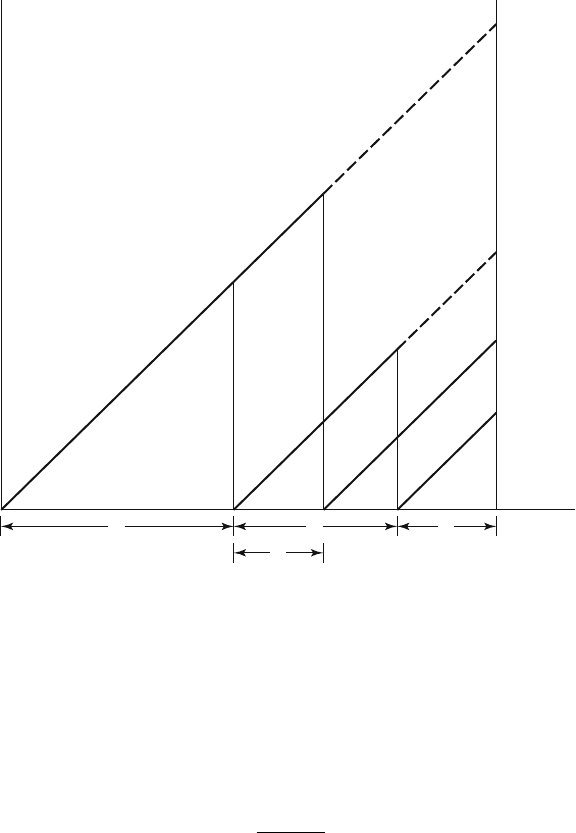Keyfitz N., Caswell H. Applied Mathematical Demography
Подождите немного. Документ загружается.


15.3. Sisters and Aunts 385
Grandmother of
girl aged a
Mother
Aunt born at
age y + u
of grandmother
B
t–a
l
a
Girl aged a
y x
u
a
Figure 15.3. Lexis diagram for aunt born after mother.
earlier, we can use this result whether or not the mother is now alive. All
that remains is to integrate out the condition that the girl aged a was born
when her mother was aged x:
A
young
a
=
β
α
S
young
x+a
e
−rx
l(x)m(x) dx,
or written out in full so as to accord with Figure 15.3,
A
young
a
=
β
α
β
α
x+a
0
l(y + u)
l(y)
m(y + u)
e
−ry
l(y)m(y)
×
e
−rx
l(x)m(x)
du dy dx.
The application of the same principles to nieces and first cousins (Figure
15.4) is found in Goodman, Keyfitz, and Pullum (1974). [The reader can
show how to go on to second- and higher-order cousins, as well as great
aunts and other distant relatives.]

386 15. The Demographic Theory of Kinship
y x
z w
a
Grandmother of
girl aged a
Aunt born at age z < y
of grandmother
Mother of girl aged a
Cousin of girl aged a
Girl aged a
Figure 15.4. Lexis diagram for cousin of a girl aged a through mother’s elder
sister.
15.4 Mean and Variance of Ages
For each kin whose expected number can be calculated, so can the mean
age. Consider the descendants, for example, of daughters already born to
a woman aged a>α. These number
a
α
m(x) dx, and their mean age must
be
a
α
(a − x)m(x) dx
a
α
m(x) dx
= a − ¯x
a
, (15.4.1)
where ¯x
a
is the mean age of the childbearing function m(x) up to age a.
The mean age of children still alive to the same woman aged a is
a
α
(a − x)m(x)l(a − x) dx
a
α
m(x)l(a − x) dx
. (15.4.2)

15.5. Changing Rates of Birth and Death 387
The mean age of granddaughters of women aged a>2α is similarly
a
α
l(x)m(x)
a−x
α
(a − x − y)l(y)m(y) dy dx
a
α
l(x)m(x)
a−x
α
l(y)m(y) dy dx
. (15.4.3)
One can go to the variance of ages of descendants in the successive gen-
erations. Thus for the variance of ages of living daughters of a woman aged
a we would have
σ
2
a
=
a
α
(x −
¯
¯x)
2
m(x)l(a − x) dx
a
α
m(x)l(a − x) dx
, (15.4.4)
where
¯
¯x is the mean age of women up to age a at the birth of their children,
weighted by the survival function l(a − x). Here, as elsewhere, no account
is taken of heterogeneity in ages and rates of childbearing, or of the spac-
ing of children imposed by the sterile period of pregnancy and afterward.
The simplification has negligible consequences for the expected number of
daughters, or for the probability of a living grandmother, but does matter
for expected sisters, aunts, and more distant collateral relatives, as well as
for variances in all kin.
15.4.1 Ascertainment
Such results illustrate the concept of ascertainment, the way information
has been obtained, used in genetics and applied in demography by Mindel
C. Sheps. Consider the expected children of a given person. When the per-
son is a child just born, her expected future daughters are
β
α
l(x)m(x) dx
prospectively; once she has passed age β,theyare
β
α
m(x) dx retro-
spectively; the corresponding mean ages are
β
α
xl(x)m(x) dx/R
0
and
β
α
xm(x) dx/G
0
, the latter always being greater. The expected grandchil-
dren calculated retrospectively for a woman of 85 differ from the prospective
number of grandchildren of a child just born. In a cohort, individuals may
be ascertained by the occurrence of a “signal” event at some point in their
lives—the signal event may be having a second child, or being caught in a
survey at time t. (Sheps and Menken 1973, p. 341.) Expressions for extended
kin provide further illustrations.
15.5 Changing Rates of Birth and Death
This chapter has been restricted to the stable case, in which we suppose a
fixed regime of mortality and fertility to be in force over a long past period

388 15. The Demographic Theory of Kinship
and continuing into the present. Yet the theory can be extended to cover
certain kinds of change in the regime.
For an example of how changing rates would be accommodated, let us
reconsider the probability that a woman aged a has a living mother, the
expression M
1
(a) of (15.1.3). The conditional probability that the mother
is alive, l(x + a)/l(x), must now be determined by the chance of survival
appropriate to the changing death rates actually experienced by the cohort
aged x+a at time t, that is, born at time t−x−a. The ratio l(x+a)/l(x)in
the formula would have to be taken from the appropriate cohort life tables,
a different table for each value of x. This is certainly possible, though
awkward enough that no one is likely to do it.
In addition the distribution of x, the age at childbearing, is affected by
the instability; if, for instance, the actual age distribution is younger than
the stable one, (15.1.3) has to be modified to allow a greater weight to l(x+
a)/l(x) for younger x, thereby increasing the probability that the mother is
still alive. Thus the factor e
−rx
l(x)m(x)inM
1
(a) would have to be replaced
by numbers proportional to the actual ages of mothers prevailing a years
earlier, say w(x|t − a). Result 15.1.3 would thus be replaced by
M
1
(a)=
β
α
l(x + a)
l(x)
w(x|t − a) dx,
where w(x|t −a) is the age distribution of women bearing children a years
ago, or at time t − a.
Analogous considerations permit a straightforward rewriting and reinter-
preting of all the formulae of this chapter in a way that dispenses with the
stable assumption insofar as it affects earlier age distributions. Goodman,
Keyfitz, and Pullum (1974) provide these more general formulae. Interpre-
tation for fixed rates is simple: the given schedules l(x)andm(x)imply
certain mean numbers of kin. The corresponding statement for changing
rates is unavoidably more complicated.
15.6 Sensitivity Analysis
A main use of the kinship formulae here developed is to ascertain the ef-
fect of changes in the demographic variables on kinship. How much does a
younger age of marriage and of childbearing reduce the number of orphans?
What is the effect of a fall in the birth rate on the number of grandchil-
dren of a person of a given age chosen at random? What does a uniform
improvement in mortality at all ages do to the number of living aunts of a
girl of given age?
Merely looking at the formulae does not tell much more than we know
without them. Intuition suggests that the fraction of girls aged a who have
living mothers must depend primarily on death rates (specifically those

15.6. Sensitivity Analysis 389
between the time of childbearing and a years afterward) and secondarily
on birth rates—most of all, on whether children are born at young or older
ages of mothers. In a smaller way yet it ought to depend on the overall
rate of increase, because with given death rates and with birth rates in a
given proportional distribution a faster growing population has somewhat
younger mothers. But a quick look at (15.1.3) reveals only that M
1
(a)is
a function of birth and death rates, without clearly suggesting the amount
or even the direction of the relation.
15.6.1 Decomposition of M
1
(a), the Probability of a Living
Mother
Once a computer program for an expression such as (15.1.3) for M
1
(a)is
available, it is possible to make small variations in any part of the input—
add 10 percent to the birth rates at certain ages while leaving the life
table intact, for instance—and see the effect on the probability of a living
mother. Here we will try to see how such variations operate theoretically, by
using the approximation to M
1
(a) developed as (15.1.7) or, written slightly
differently,
M
1
(a) ≈
l(κ + a)
l(κ)
+
σ
2
2
l(κ + a)
l(κ)
. (15.6.1)
The main effect of raising the mean age of childbearing is to replace
mortality in an interval at the original κ with mortality around a + κ,as
is evident from application of (1.6.5):
l(κ + a)
l(κ)
=exp
−
κ+a
κ
µ(t) dt
. (15.6.2)
If the death rate is nearly constant with age, or if a is small, M
1
(a) depends
little on the value of κ. The second term on the right-hand side of (15.6.1)
is negative through most of the life table and is considerably smaller than
the first, unless a is a very old age. The rate of increase of the population
enters only through κ, which for a given life table is younger the higher the
rate of increase.
If mortality µ(x) between κ and κ + a increases by an amount k at every
age, the survivorship l(κ + a)/l(κ) will diminish in the ratio e
−ka
,andthis
is the only effect of a constant mortality addition on M
1
(a). Hence the
new
M
1
(a) is equal to e
−ka
M
1
(a). The reason that the weighting factor
e
−rx
l(x)m(x) in (15.1.3) remains unaffected is that a uniform change in
mortality causes a change in r that offsets the change in l(x) as far as age
distribution is concerned, a matter discussed in Section 10.1.

390 15. The Demographic Theory of Kinship
15.6.2 Other Progenitors
If mortality at all ages is increased in the uniform amount k, the probability
of a living grandmother will change to
M
2
(a)=
β
α
e
−k(a+x)
M
1
(a + x)e
−rx
l(x)m(x) dx, (15.6.3)
which cannot be simplified without approximation. But let x be replaced
in e
−k(a+x)
by κ
, the mean age at childbearing for the mothers still alive.
Then, taking the exponential outside the integral, we have approximately
M
2
(a) ≈ e
−k(a+κ
)
M
2
(a).
For great grandmothers
M
3
(a) ≈ e
−k(a+κ
+κ
)
M
3
(a),
where κ
is the mean age at childbearing for grandmothers still alive. In
practice we do not have data on κ
or κ
and would suppose them to be
close to κ; hence the outcome in general is
M
i
(a) ≈ e
−k[a+(i−1)
κ
]
M
i
(a). (15.6.4)
If k is small, so that e
−ka
is nearly 1 −ka, we obtain the following finite
approximations for the difference in the several M
i
(a) on adding k to the
force of mortality:
∆M
1
(a)=−kaM
1
(a)
∆M
2
(a)=−k(a + κ)M
2
(a)
∆M
3
(a)=−k(a +2κ)M
3
(a).
With these approximations, if one of two populations has mortality higher
at every age by 0.003, and if κ is 27.5, for women aged a =20thechance
of having a living mother is 0.94 as high as in the other population; of
a living grandmother, 0.86; and of a living great-grandmother, 0.78. On
the more precise (15.6.4) the last three numbers become 0.942, 0.867, and
0.799, respectively.
Venezuela has somewhat higher mortality than the United States; we
note from Table 15.1 that for a Venezuelan girl aged 20 the probability
of having a living mother is in the ratio 0.932/0.959 = 0.97; of a living
grandmother, in the ratio 0.85; of a living great-grandmother, in the ratio
0.64, all ratios to the United States. The gradient as one advances to more
remote ancestors is steeper than that of (15.6.4) based on fixed differences
of µ(x).
A more complete analysis would decompose the difference between the
two countries in, say, the probability of a living grandmother into two
components: (1) that due to mortality differences, and (2) that due to differ-
ences in the pattern of births. This is readily accomplished arithmetically,

15.6. Sensitivity Analysis 391
once an appropriate computer program is available, simply by permuting
the input data, as was done in Table 10.2.
15.6.3 Effect of Birth Pattern on Living Progenitors
The main variation in M
1
(a) as far as births are concerned occurs through
the mean age of childbearing κ. We found that
M
1
(a) ≈
l(κ + a)
l(κ)
;
therefore taking logarithms of both sides and differentiating gives
1
M
1
(a)
dM
1
(a)
dκ
= −
µ(κ + a) − µ(κ)
,
where µ(κ) is the force of mortality at age κ. In finite terms
∆M
1
(a)
M
1
(a)
≈−
µ(κ + a) − µ(κ)
∆κ;
that is, the proportionate change in the chance of a living mother is minus
the difference in death rates over an a-year interval times the absolute
change in κ. With the death schedule of Madagascar, 1966 (Keyfitz and
Flieger 1971), and its κ of about 27.5, using for µ(27.5) the approximation
5
M
25
=0.01740, and for µ(κ + a)=µ(27.5 + 20) = µ(47.5) the rate
5
M
45
=0.02189, we have
∆M
1
(a)
M
1
(a)
≈−(0.02189 − 0.01740)∆κ = −0.0045∆κ.
For each year later of average childbearing the chance of a woman of 20
having a living mother is lower by 0.45 percent.
The change with a is found in the same way to be
∆M
1
(a)
M
1
(a)
= −µ(κ + a)∆a,
and for a = 20, κ =27.5, this is
−µ(47.5)∆a = −0.02189∆a.
For a 5-year interval the proportionate decrease in M
1
(20) ought to be 5
times as great or 0.109. In fact Table IIIa of Goodman, Keyfitz, and Pullum
(1974) shows
M
1
(25) − M
1
(15)
2
= −
0.7817 − 0.6421
2
= −0.0698;
and as a proportion of M
1
(20) = 0.7126, this is −0.0698/0.7126 = −0.098,
about as close to −0.109 as we can expect with the crude approximations
used.

392 15. The Demographic Theory of Kinship
Table 15.3. Effect of changed birth rate on probability of ancestor being alive,
Madagascar females, 1966
Difference in Probability of Having a Living:
Age of Great-
woman Mother Grandmother grandmother
a
M
1
(a) − M
1
(a) M
2
(a) − M
2
(a) M
3
(a) − M
3
(a)
After Lowering the Birth Rate for Women 20–24 by 0.01
00. −0.00268 −0.00529
20 −0.00025 −0.00423 −0.00109
40 −0.00228 −0.00103 −0.00000
60 −0.00067 −0.00000 −0.00000
After Lowering the Birth Rate for Women 40–44 by 0.01
0 0. +0.00395 +0.00404
20 +0.00109 +0.00345 +0.00057
40 +0.00199 +0.00051 0.00000
60 +0.00036 0.00000 0.00000
To find the effect of a change in fertility at particular ages one can run the
program twice, once with the observed regime of mortality and fertility, and
once with the specific birth rate for age 20–24 lowered by 0.01. Differences
for progenitors are shown in Table 15.3. A drop in fertility at age 40–44
lowers the average age of childbearing and hence raises the chance of a
living grandmother. Other items can be similarly interpreted.
15.6.4 Comparison of Effect of Birth and Death Rates
Robert Sembiring (1978) has experimented to determine whether the num-
bers of particular kin are affected more by birth or by death rates. As an
example of the procedure we consider the number of female cousins that a
girl aged a would be expected to have through her mother’s sister and use
the technique of permuting the input data, as in Section 10.1.
To separate the effects of mortality from those of fertility nine calcu-
lations were made of the curve of expected cousins by age. Three levels
of fertility were used, those of Costa Rica for 1960, the United States for
1959–61, and Sweden for 1958–62, all pertaining to 1960 or thereabout. The
gross reproduction rates of the three countries were 3.891, 1.801, and 1.080,
respectively. Each of these levels of fertility was paired with each of three
levels of mortality taken from the Coale and Demeny West series model
tables, with
o
e
0
values of 70, 55, and 40. The numbers chosen represent ap-
proximately the range of mortality and fertility among human populations.
The resulting nine curves for the average number of living cousins in the
female line (i.e., daughters of maternal aunts) are shown in Figure 15.5.

15.6. Sensitivity Analysis 393
0 5 10 15 20 25 30 35 40 45 50 55 60 65 70 75 80 85
Age
1
.528
2
3
4
5
6
7
8
9
10
11
12
.249
.517
.653
.973
1.272
2.451
3.796
5.074
8.502
12.633
Fertility
Mortality
3.798
2.781
.636
.267
.401
.684
.994
1.100
1.871
2.709
4.846
Upper curve: Costa Rica, 1960
Middle curve: U.S., 1959–61
Lower curve: Sweden, 1958–62
= 70
= 55
= 40
Expected cousins in female line
o
e
0
o
e
0
o
e
0
Figure 15.5. Expected number of cousins still alive.
The three curves for high (Costa Rican) fertility are above those for in-
termediate fertility, and these again are mostly above those for low fertility.
Apparently fertility has more effect on the number of living cousins than
does mortality. With high fertility the number of cousins reaches a sharp

394 15. The Demographic Theory of Kinship
Table 15.4. Mean number of living first cousins in the female line of a woman
aged 20, for artificial populations constructed by fertility of Costa Rica, the
United States, and Sweden, about 1960, in all combinations with mortality of
Coale–Demeny model West tables having
o
e
0
values of 40, 55, and 70 years
Fertility
Costa Rica United States Sweden
Mortality G
0
=3.891 G
0
=1.801 G
0
=1.080
o
e
0
= 40 4.7292 1.0998 0.4009
o
e
0
= 55 7.9888 1.8502 0.6789
o
e
0
= 70 11.3518 2.6006 0.9657
peak at ages 25 to 45; with lower fertility and lower mortality the curve
peaks less sharply. Note that no actual population combines a gross repro-
duction of 3.891 with an expectation of life of 70 years; therefore the peak
of 12.633 female maternal parallel cousins is purely hypothetical. The com-
bination of United States or Swedish fertility with this high expectation of
life represent possible real situations.
All of the expressions in this chapter apply to male as well as to female
kin, but with one difference. This difference arises out of the fact that
we know the mother was alive at the birth of her child, but we know
only that the father was alive 9 months before the birth. To apply to
males, the formulae would have to be adjusted for the three-quarters of a
year of additional mortality, which could be appreciable for certain kin in
populations subject to high death rates.
A rough approximation to the total number of first cousins (i.e., of
both sexes) would be obtained by multiplying the material parallel female
cousins here given by 8; this would be improved by making the correspond-
ing calculation for the male line and for mixed lines. An approximation to
the number of cousins implied by other schedules of mortality and fertility
would be obtained by two-way quadratic interpolation, using
o
e
0
and the
gross reproduction rate as indices. This is especially feasible for mortality;
note that the number of cousins for
o
e
0
= 55 is almost exactly the mean
of the numbers for
o
e
0
=40and
o
e
0
= 70 (Table 15.4). Interpolation may
be useful even with an available program because of the large amount of
computer time required for the exact calculation.
15.7 The Inverse Problem: Deriving Rates from
Genealogies
The inverse problem is of practical interest to those who must make in-
ferences regarding birth and death rates for areas or times for which
